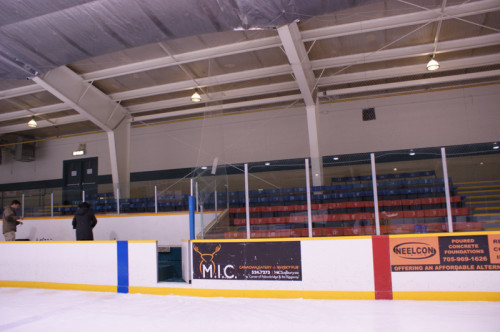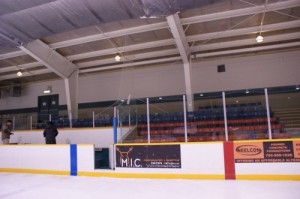MANITOULIN—If Mike Meeker, coach of the Manitoulin Secondary School (MSS) girls’ hockey team, had his way, the girls’ team would have an eager fan-base, packed arenas during game play and a busy evening schedule.
Since he doesn’t get his way, the girls’ play to empty stadiums, have virtually no fan-base and never play a game any later than 4 pm.
The unwritten rule has been in place since the start of girls’ high school hockey two decades ago, Mr. Meeker explained. Unlike the boys’ hockey team, girls can play both high school hockey and “rep” or “carded” hockey—the bantam and midget leagues or former Islanders, for example. Since the boys can only play one or the other, the boys on high school teams don’t have to worry about conflicting schedules in the evenings.
The girls, on the other hand, do. With several of the girls’ teams primarily made up of players who skate evening games with teams like the Lady Wolves or Ice Angels, coaches at other schools push for daytime games to avoid conflicting with the girls rep hockey schedules.
Dave Makela, convenor of both the boys’ and girls’ leagues, said “there’s no rules against evenings or weekends. It’s just that they (coaches) want to let teams field full rosters.”
Mr. Meeker, on the other hand, feels evening and weekend games can be a reality for girls’ teams. He has proof—the Mustangs held Saturday games for two years straight and only had a team cancel once. The cancellation was due to weather, not game conflict. The girls’ team would play, then the boys’ team, both drawing “huge” crowds, Mr. Meeker said.
“It requires some extra effort to avoid conflicts, but it can be done,” Mr. Meeker argued. “We’ve done it.”
This is something that could change in the future though, both men noted. In southern Ontario, the prohibitions the Sudbury District Secondary School Athletic Association (SDSSAA) has placed on the boys’ teams regarding rep and high school hockey doesn’t exist, Mr. Makela noted.
“There’s always discussion about whether or not we want to continue this prohibition,” Mr. Makela explained. “It holds our boys’ teams back at OFSAA (Ontario Federation of School Athletic Associations).”
Mr. Meeker, however, said he wouldn’t mind if the prohibition extended to the girls’ league, though he also added that he thought it wasn’t the only answer.
“There has to be a change in how people look at girls’ hockey,” he said. “It’s changed. These girls are getting really good. They try hard, they play hard. Girls’ hockey is becoming better known and it could become well known if it was given the same priority as boys’ hockey.”
The girls’ team recently had to shift their regular practice at the M’Chigeeng arena after they were “bumped” for a boys’ league.
Some people are of the mind that forbidding rep hockey players in the girls’ league would “gut” the team and severely hamper the quality of play, but Mr. Meeker is of a different opinion.
“When we’re short a few of our ‘star’ players, the others pick up the ball,” Mr. Meeker noted. “They play better to make up the difference, and that’s how it would be in the league.”
While he does note that, at times, players play stronger when facing a better team, there are equal incidents where the athlete loses hope and becomes dejected.
“No one likes a score of 6-0, or worse,” he said. “It’s crushing and your play starts to fall apart.”
Randy Pascal, a sports journalist with SudburySports.com, told The Expositor that “the overall calibre of play would drop dramatically, although that’s not necessarily a good reason to allow rep girls to continue playing when the boys can’t.” He mentioned that if the prohibition came into place, several of the 18 teams in the league would “fold outright.”
Mr. Meeker admits banning rep players could cause teams to fold, but suggested that perhaps it would simply allow high school girls who aren’t playing rep hockey a chance to play in the league.
“Sure, the team might not ‘the best’ in the league, but at least they’d be there for fun.”
He said the rep players do not put a priority on high school hockey and it is an “afterthought” for them, a way to gain a few extra practices for the “real hockey.”
“Sometimes, those teams will play the minimum amount of games necessary to reach the playoffs, then not bother to play again until league championship play starts,” he added.
Season length is another issue that Mr. Meeker is railing against. The disparity between the number of games and blackout periods in girls’ hockey, when compared to boys’ hockey, is quite obvious. The girls have a short season of 12 games, while the boys can play up to 20 games a season.
“While the boys’ teams can play up to 20 games, you’ll rarely find they do,” Mr. Makela said. He also noted that since the girls miss school to play hockey, the shorter season evolved over time.
The necessity of teams playing during the day also created blackout periods that don’t exist on the boys’ side of the spectrum. Girls’ teams cannot play or practice during the exam period or during the Christmas break.
“It’s really not fair,” several members of the girls’ team expressed following a 3-1 win on December 21. With the boys’ team bringing in extra money through door fees, they’re able to afford perks like jackets and equipment. The girls don’t get the same amount of money.
“It took us four years to get new jerseys,” Victoria Niven, one of the Mustangs, noted. The girls had played in those jerseys for the first time that game.
The empty arenas take a toll on the girls morale, too.
“It’s so hard,” Emily Van Kesteren said.
“It makes a difference,” added Bridgette McDonald. “It’s just parents. No fans. It doesn’t pump us up.”
Missing school doesn’t help the girls, either. Though they have to continue to excel in school in order to play for the girls’ team, they’re forced to catch up on any missed content on their own.
“It’s hard if you have two sports, Emily added. Carly Newlands, a teammate, added, “If you miss, you have to catch up on your own.”
Some classes, like phys-ed, have a participation element involved in grading and girls can take a hit there, too. Mr. Meeker, however, noted that participation policies vary from school to school.
“Some teams are docked points, some are given points for participating in sports,” he said.
Though money isn’t the paramount reason why the girls’ team is hoping for a policy change to let them play evening and weekend hockey, it’s likely to become more important after the Northeast Town killed their primary fundraiser with a recent motion. The girls are now facing a several thousand-dollar deficit for next year, a deficit that could be battled with an income from fans at the door.
“Money isn’t the reason why we want evening games,” Mr. Meeker said. “It’s a great bonus of evening and weekend games. There are girls out there who love playing hockey but might not be able to if it costs a few extra hundred to play the season.”
Ultimately, the decision rests in the hands of the girls’ hockey board at SDSSAA, which is comprised of coaches and other invested parties. The board meets twice a year, at the start and end of the season, and occasionally during the season.
The Mustangs face an uphill battle getting the Sudbury teams to change their minds, however, as the teams also get a break on the ice cost with the use of low-demand ice time.






